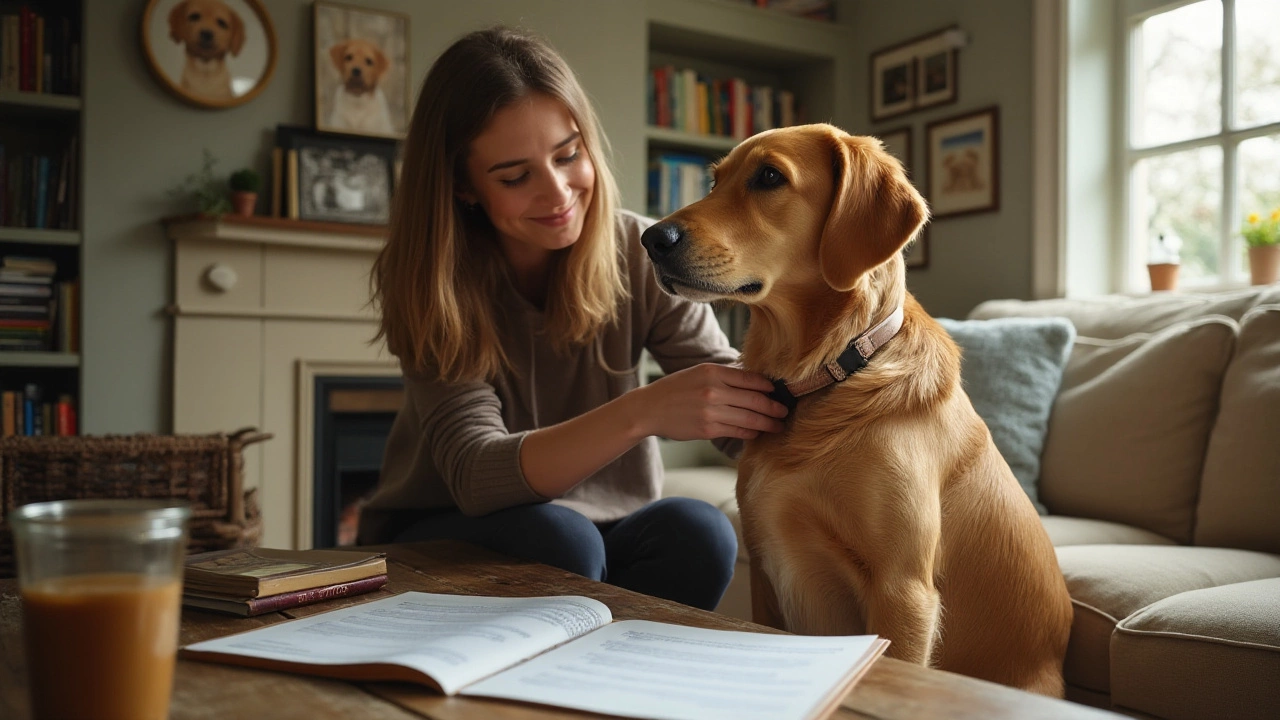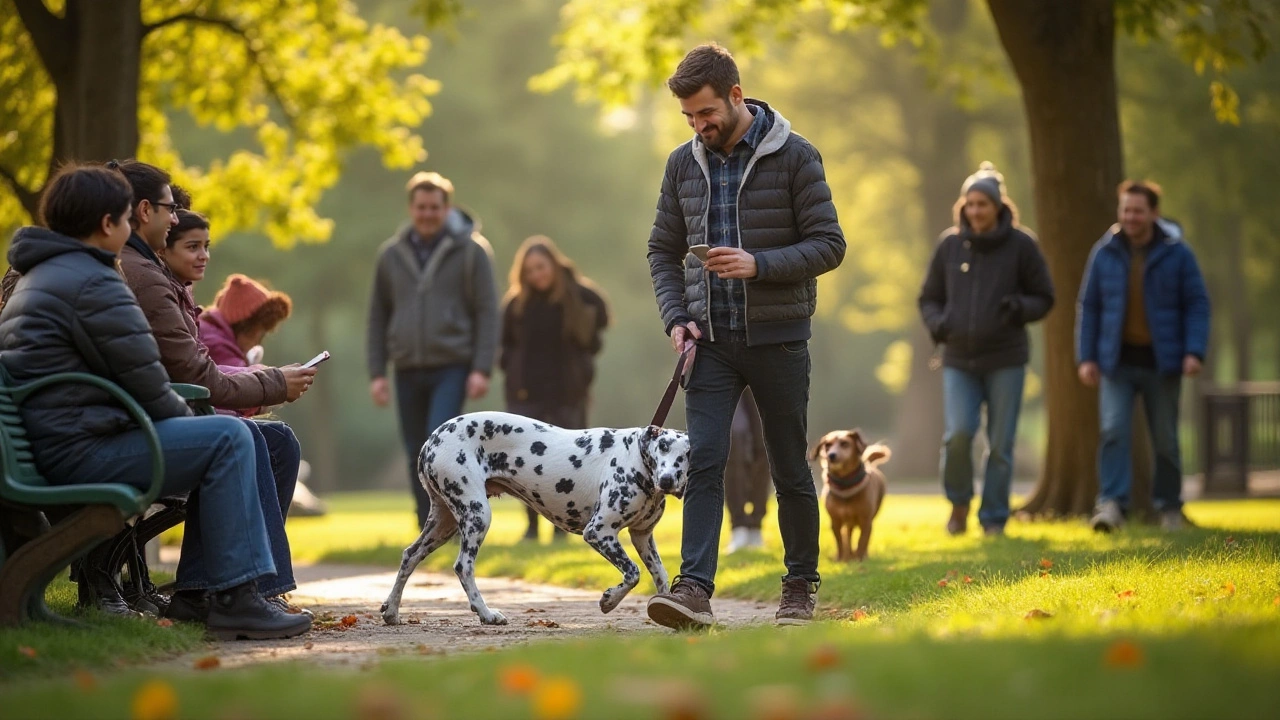When it comes to our furry companions, ensuring their well-being while balancing practicality can sometimes pose a dilemma, especially regarding something as simple as a dog collar. Many pet owners are uncertain about whether these collars should stay on all the time or if there are situations where it's best to let their pups go au naturel.
Dog collars serve a crucial role in not just adorning your pet with a stylish accessory but primarily acting as a tool for identification and safety during walks. While having a collar on 24/7 might seem an easy choice, there are downsides to consider, such as the potential for irritation or even more serious accidents.
It's essential to weigh aspects like your dog's personality, their typical environment, and daily routines when making this decision. By understanding the benefits and risks, you can make the best choice for your pet, ensuring they are both safe and comfortable. Let's take a closer look at what factors play into this choice and how you can keep your furry friend happy and healthy.
- Benefits of Keeping a Collar On
- Potential Risks of Constant Wear
- Factors to Consider
- Tips for Safe Collar Use
- Alternatives to Constant Collar Wear
Benefits of Keeping a Collar On
A dog collar is much more than a mere accessory; it serves multiple vital roles in both the life of your pet and your own peace of mind. Perhaps the most notable benefit of keeping a dog collar on your pet all the time is identification. Imagine walking in a bustling city or even in quiet suburban areas, and the unfortunate event your beloved pet gets lost. The collar, equipped with identification tags, can be the lifeline that brings your pet back to you. With contact details readily available, this small piece of gear becomes an invaluable tool for swiftly reuniting lost pets with their owners.
In addition to ID tags, dog collars are essential for attaching leashes, which are necessary when taking your dog out for walks or even a trip to the vet. The leash-collar setup offers an immediate way to manage your dog in unexpected situations, ensuring their safety and control. For active dogs or those still in training, collars provide the stability needed for correcting pulls and the occasional stubbornness. This makes the walking experience much more pleasant, both for you and your furry companion.
Another impressive benefit of collars is their role in portraying your dog’s health background. Many pet owners are now opting for health indicator tags, which can display crucial information about any medical conditions or specific care needs their pet may have. In emergencies, this information can be vital for those stepping in to help, swiftly understanding any precautions or medications required.
A notable quote by Cesar Millan, famed dog trainer, resonates well with this:
"A collar is not just an accessory; it is a key component of a responsible and protective approach to handling our dogs."This reinforces the sentiment that collars encircle far more than our dogs' necks; they encompass identity, safety, and care, all essential in our role as loving pet owners.
Moreover, certain collars come with in-built technology, such as GPS trackers. This can be particularly beneficial for those outdoor adventurers who love to explore. Although these smart collars come at a premium, the reassurance they provide to pet owners can be priceless. Additionally, visibility is a lesser-considered yet practical benefit, especially in low-light conditions. Reflective or light-weighted collars ensure that even when the sun sets, your dog is visible, significantly minimizing the risk of accidents.
Ultimately, the benefits of a collar in ensuring your pet's safety, accessibility in emergency scenarios, and keeping them connected to you cannot be overstated. While the choice of whether your dog should wear a collar at all times involves many factors, its advantages are significant and worthy of a thoughtful discussion for every dedicated pet owner.
Potential Risks of Constant Wear
Keeping a dog collar on all the time might seem harmless, but several potential issues are worth considering for the sake of your furry friend’s comfort and health. First, there's the risk of chafing, which can often lead to skin irritation. The constant rubbing of a collar, especially if it's not the perfect fit, can cause discomfort for your pet. This irritation may even progress into rashes or hot spots, and in more severe cases, cause hair loss or skin infection. It's essential to regularly inspect your dog's neck for signs of wear or discomfort, particularly if they wear their collar most of the time.
Another risk factor is the possibility of collar-related accidents. Dogs are curious by nature, and a collar can get caught on various objects around the house or while playing outdoors. This is especially true for dogs left unattended or prone to exploring tight spaces. Such situations can cause injury or panic, leading to potentially dangerous outcomes. A known risk, the 'collar strangulation,' is a rare but serious concern expressed by pet safety specialists. Renowned veterinarian Dr. Emily Weiss once stated, “The chance of collar interference during play or exploration can lead to the unexpected and is a key reason to consider supervised play without collars.”
A collar that stays on constantly might also hinder muscle and skin development, particularly in younger dogs who are still growing. Restrictive collars can prevent the muscles around the neck and shoulders from developing naturally, affecting their posture and movement. Moreover, collars that are either too tight or too loose can cause ongoing stress and anxiety for dogs. Tight collars may impede breathing or swallowing, while loose collars run the risk of slipping off, losing their purpose altogether.
For some breeds or individual dogs, allergies to materials used in collars can be a concern. Many collars are made from synthetic fabrics or metals that might not agree with sensitive skin, leading to allergic reactions. Symptoms could include constant scratching, red skin, or swelling around the neck. To avoid such issues, consider trying out hypoallergenic collars made from natural materials.
Finally, pet owners should not overlook the psychological impact of a constant collar. Some dogs can develop a dislike or aversion to their collars, associating them with negative experiences like trips to the vet or punishment. This can create a negative feedback loop, where each time the collar is put on, the dog becomes stressed or resistant. Understanding and being attuned to such behavioral cues can significantly improve the well-being of your pet.

Factors to Consider
As a responsible pet owner, deciding whether to leave your dog collar on all the time requires evaluating several important factors. From the breed and size of your dog to their individual temperament and lifestyle, these elements can significantly influence what is best for your furry friend. Owning a pet is a journey that involves keen observation and adaptation, all in the interest of health and safety. Let's dive deeper into some primary considerations that can guide you on this topic.
Firstly, the breed and size of your dog have a direct impact on collar usage. For instance, larger breeds with thicker coats might experience discomfort if their collars are too tight, while small dogs might get caught in things if the collar is too loose. The American Kennel Club advises that the collar should allow for a two-finger gap between your dog’s neck and the collar, balancing comfort and security. Yet, some owners of breeds with unique head structures, such as Greyhounds, might prefer martingale collars for everyday wear due to their specialized fit.
"A collar should serve as a safety tool, not a source of risk," advises veterinarian Dr. Anna Thompson from the New Zealand Veterinary Association.
Another key aspect is your dog's behavior and activity levels. An especially active dog, one that loves exploring tight spaces or digging, might encounter situations where the collar becomes a hazard. It's wise to be observant of your pet's tendencies and adjust collar-wearing habits accordingly. If your dog is more of a couch companion, the risk is minimized, but still not absent. Habitual tugging at a collar might indicate discomfort or a poor fit, needing your attention.
The environment in which your pet spends most of their time also influences the decision. For those dogs living primarily indoors, with rarely unsupervised outdoor access, collars might not need to be worn as frequently. This is different for pets with routine outdoor adventures, where identification tags are crucial. For those enjoying nature hikes or off-leash parks in New Zealand's beautiful landscapes, a collar with an ID tag could be their ticket home if they wander too far.
Health conditions and age form another critical consideration. Senior dogs with arthritis or other conditions may find collars bothersome, something to carefully weigh. Likewise, puppies may outgrow their collars quickly, necessitating frequent checks and adjustments. It's vital to monitor for any neck sores or hair loss, signs indicating it's time to rethink collar usage. Some may even opt for alternatives like microchipping for identification, a choice growing in popularity for tech-savvy pet owners.
Ultimately, the fabric and make of the collar itself can't be overlooked. Synthetic materials might cause allergies in some dogs, while leather can be more forgiving. It's worth exploring different types to find what your pet tolerates best, so your furry companions enjoy both comfort and safety. After all, our pets rely on us to make the best decisions for their health and happiness, making careful consideration imperative when deciding how often to buckle on their collars.
Tips for Safe Collar Use
When considering the best practices for using a dog collar, it's important to focus on both comfort and safety for your pet. A well-chosen collar doesn’t just provide a means for attaching a leash but can also be a vital tool for identification. Begin by selecting the right size. A collar that is too tight can cause discomfort and potentially harm your pet, whereas one that is too loose might slip off, making it ineffective. A simple way to check the fit is the 'two-finger rule': you should be able to comfortably slide two fingers between the collar and your dog's neck. This ensures that it’s neither too tight nor too loose, offering a balance between comfort and security.
Material is another crucial factor in collar safety. Opt for durable materials such as leather or high-grade nylon, which are not only long-lasting but also comfortable for your pet to wear daily. Some owners might prefer synthetic collars, which can be a good choice for dogs that love occasional dips in water, as they dry quickly and won’t harbor a wet-related smell. Reflective or LED collars can be great options for nighttime use, as they enhance visibility and safety during evening walks.
When it comes to puppies, it’s essential to monitor growth and adjust the fit of their collars regularly to ensure they’re comfortable and prevent any injuries. It’s not uncommon for puppies to outgrow their first collar in a matter of months, so keeping an eye on fit helps prevent potential issues. For those with larger breeds or particularly muscular dogs, strong and durable hardware is crucial. Ensure the buckle is secure, and choose a collar that can withstand pulling if your pet is prone to sudden bursts of energy.
Consider rotating collars regularly, especially when indoors, to prevent skin irritation. Constant rubbing in one spot can lead to fur loss or even skin damage, particularly for breeds with delicate or sensitive skin. Spot checks of your dog’s neck can be helpful to catch any issues early on. Removing the collar while inside the safe confines of your home can also allow the skin to breathe and lessen the risk of irritation or matting.
According to Dr. Kelly Inkster, a veterinarian specializing in canine behavior, "Regular checks and adjustments of your dog's collar are crucial for ensuring comfort and avoiding unnecessary injuries." Her advice underlines the importance of being vigilant and adapting your approach as circumstances change, whether it’s due to growth, coat type, or activity level, making sure that comfort and safety are always top of mind.As for identification tags, ensure they are securely attached and updated with current contact information. This can be a lifesaver if your pet ever strays from home. Microchipping offers an added layer of security, but a collar with an ID tag is often the first line of defense in reuniting lost dogs with their owners.

Alternatives to Constant Collar Wear
Dog collars are one of the simplest tools for ensuring our pets remain identifiable and safe; however, there are circumstances when leaving a collar on all day might not be the best choice for your canine companion. Thankfully, there are several alternatives for those times when constant collar wear isn't practical or desirable. One popular option is the breakaway collar. These collars are designed with a special clasp that breaks open under pressure. This feature ensures that if your dog gets caught on something, the collar will release to prevent injury. Breakaway collars are particularly suitable for adventurous dogs who love to explore tight spaces or for those who have unsupervised outdoor time.
Another viable alternative includes using harnesses. Harnesses distribute pressure more evenly across a dog's body, which can make them a more comfortable choice for walking. They come in various types, including back-clip, front-clip, and dual-clip, each serving different training and comfort purposes. Unlike collars, harnesses don't rest on a dog's neck, which can reduce the risk of neck injuries or trachea damage, especially in dogs prone to pulling.
Microchipping your dog is another highly recommended method for pet identification that doesn’t involve a collar. It's a tiny implant placed under the skin, and it provides a permanent form of ID that can be scanned by most veterinarians and shelters. Although a collar can easily be removed or lost, a microchip stays with the pet for life.
Dr. Emma Stone, a renowned veterinarian, mentions, “A microchip is perhaps the single most reliable identification method available nowadays; it's always there when you need it, unlike tags that can be lost along the way.”
For those moments when a dog collars simply isn't appropriate, such as during grooming or when your pet is resting comfortably at home, consider using pet-safe indoor tracking devices. These modern gadgets utilize Bluetooth or WiFi and allow you to track your pet’s movements within your home. Furthermore, this ensures their safety without the physical concerns of a traditional collar.
Lastly, if you are concerned about how your dog fares without a collar in terms of behavior, it's good to know that some training systems and whistles act as effective alternatives. These can be particularly useful during off-leash activities where dogs might otherwise rely on a collar for directions or restraint. Remember, the ultimate goal is to find a balance that keeps your dog comfortable, secure, and happy while still ensuring easy identification when needed. Pet owners should take into account their dog's specific needs, lifestyle, and personality while choosing any of these alternatives.
